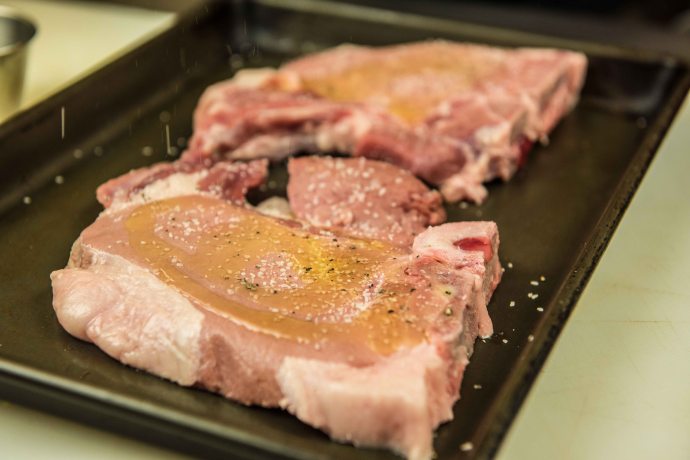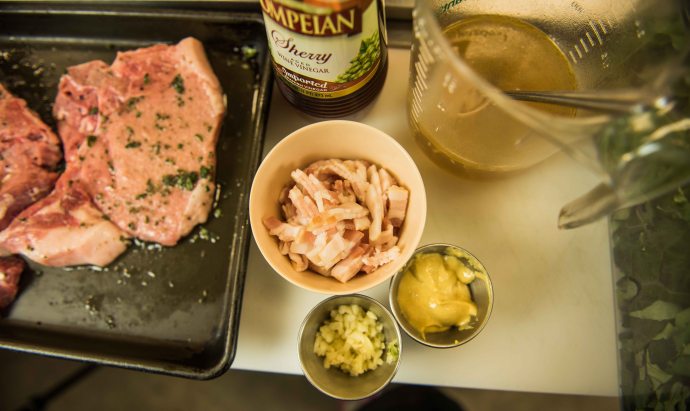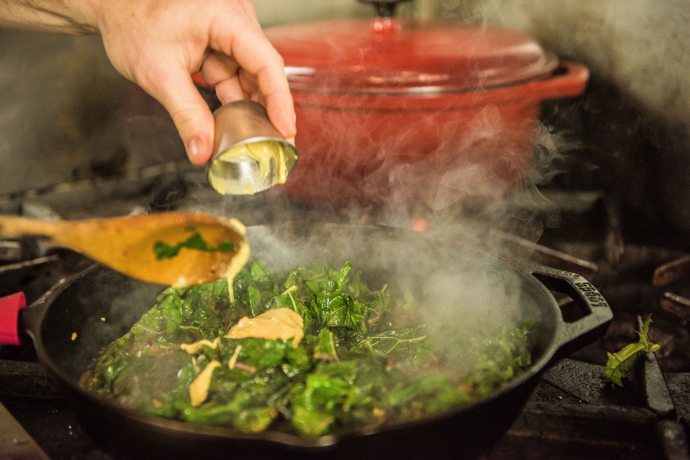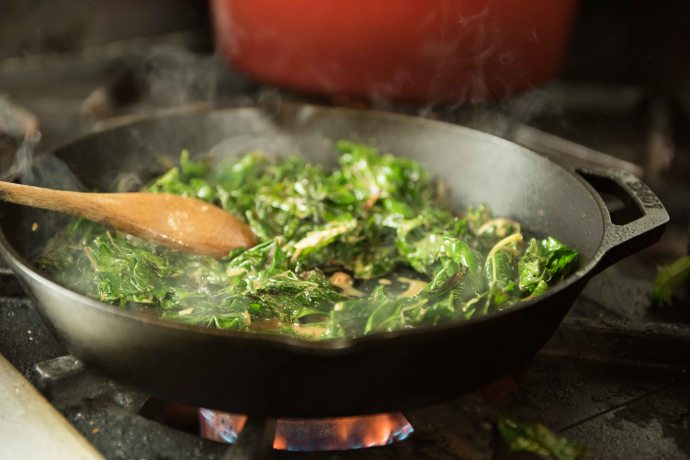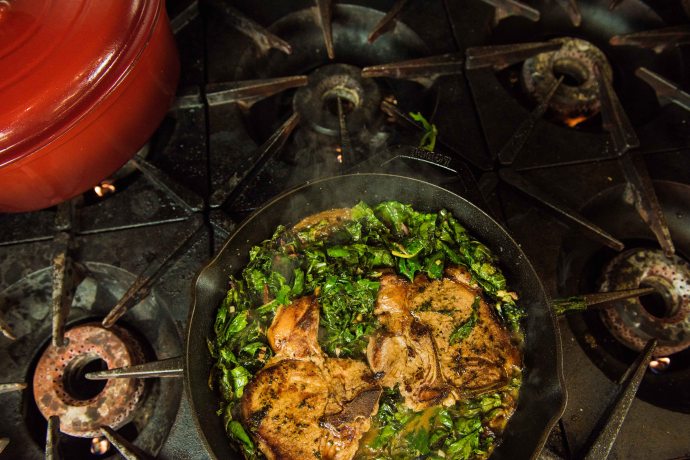Our rich, flavorful pork chops are the final product of our hog program which restores our land and supports our rural community. Our chef Reid Harrison has prepared three quick, healthy and delicious recipes using our pasture-raised, non-GMO fed, Global Animal Partnership 5+, Certified Humane pork chops.
Pan Seared Pork Chop with White Wine Rosemary Garlic Pan Sauce

Ingredients – White Oak Pastures Pork Chops, Salt & Pepper to Taste, 1 Lemon, 2 Cloves Garlic, 2 Sprigs fresh Rosemary, 2 Tablespoons White Wine, 1 Tablespoon Butter, 2 teaspoons Olive Oil, 2 Tablespoons Heavy Cream
Directions – Season Chops with salt and pepper to taste. Heat olive oil in pan till almost smoking. Add butter till sizzling and just starting to brown. Sear Pork Chops over medium high heat for 2-3 minutes on one side, then flip to other side and reduce heat to medium. Add garlic and rosemary to pan. Squeeze the juice of one lemon over the pork chops, garlic and rosemary. Occasionally spoon some pan sauce over the chops so that it cooks into the meat. Once the chops have reached an internal temp of 150F, remove them to a plate while you make the pan sauce. For the pan sauce, simply deglaze the pan with white wine, being sure to scrape up any brown bits off the bottom of the pan (make sure you don’t burn anything during the cooking process as this will make the pan sauce bitter). Reduce the wine by half, then pour in the cream stirring to marry the flavors, then melt in the butter – being sure to stir continuously so that the sauce does not break. Taste and season with salt and pepper if necessary. Pour over the pork chops and enjoy!






Pan Seared Boneless Pork Chop with Red Wine Mushroom Sauce

Ingredients – White Oak Pastures Pork Chops, Grill Salt, 1/2 Onion Julienne, 1 Cup Sliced Mushrooms, 2 Sprigs Rosemary, 2 Cloves Garlic Minced, 2 Tablespoons Red Wine, 2 Tablespoons Heavy Cream, 1 Tablespoon Butter, Salt & Pepper to taste
Directions – Season Chops with grill-salt. Heat olive oil in pan till almost smoking. Add butter till sizzling and just starting to brown. Sear Pork Chops over medium high heat for 2-3 minutes on one side, then flip to other side and reduce heat to medium. Add onions, mushrooms and rosemary to pan. Sautee with pork chops for 2-3 minutes. Remove Pork chops from pan and place on a plate once they reach an internal temp of 150F. Add the garlic to the onion & mushroom mixture. Cook until onions and mushrooms are caramelized and garlic is fragrant. Deglaze the pan with the red wine making sure to scrape up any brown bits off the bottom of the pan (make sure you don’t burn anything during the cooking process as this will make the pan sauce bitter). Reduce the wine by half, then pour in the cream stirring to marry the flavors, then melt in the butter – being sure to stir continuously so that the sauce does not break. Taste and season with salt and pepper if necessary. Pour over the pork chops and enjoy!


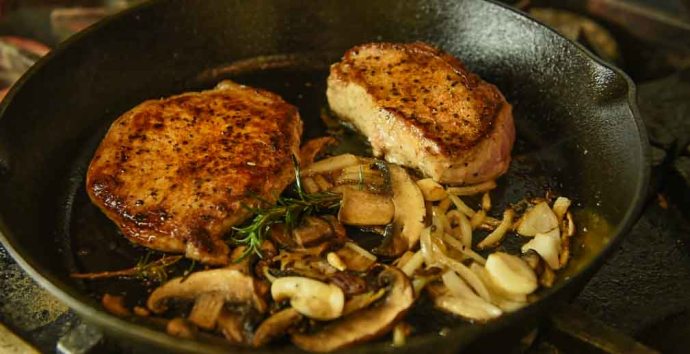


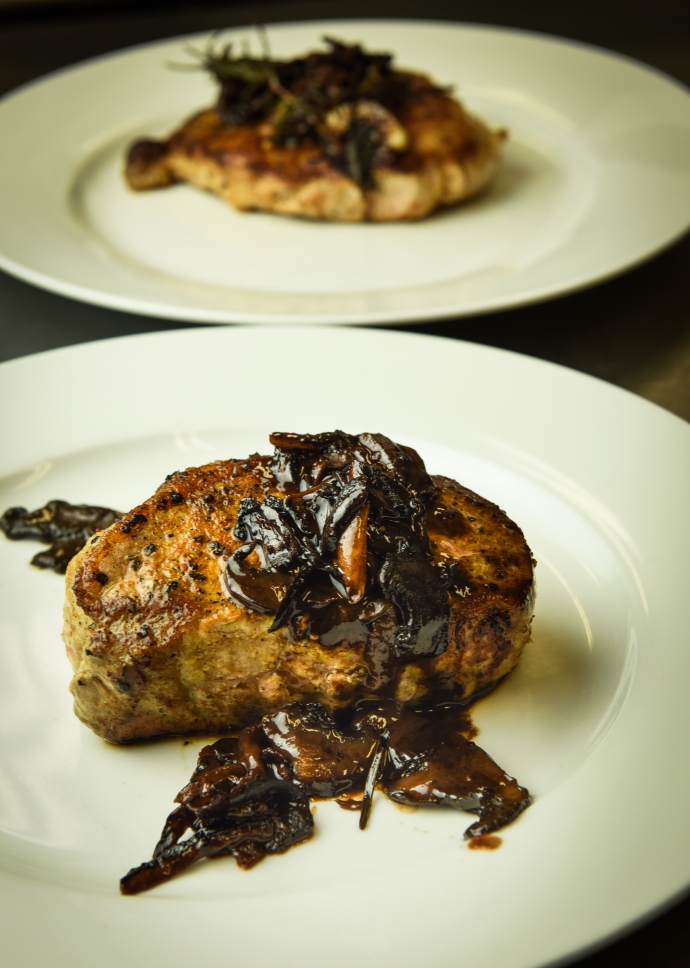
Pork Chops with Bacon and Kale

This is a delicious and healthy quick dinner, plus, the cast-iron makes for minimal mess as this is a one pot kind of dish. Not only does it taste good, but there are a lot of health benefits to adding hearty dark greens like Kale as they are a nutritional powerhouse packed with calcium, fiber, vitamins and antioxidants (you can also substitute Swiss chard, mustard greens or even baby collards).
Ingredients – 2 White Oak Pastures Pastured Pork Rib Chops, 2 TBL Chopped Fresh Oregano, 1/2 tsp Ground Allspice, Salt & Pepper to taste, 1 TBL Olive Oil, 2 Bacon Slices- thick cut, sliced, 2 Garlic Cloves – minced, 1 Bunch of White Oak Pastures Organic Kale – stemmed and rough chopped, 5 tsp Sherry Wine vinegar, 1/2 Cup White Oak Pastures Poultry Bone Broth, 2 TBL Dijon Mustard
Directions – Season Pork Chops with Oregano, Allspice, Salt & Pepper with a little olive oil. Allow to sit and marinate for 20-30 minutes. Sear over medium-high heat in a cast-iron pan, until golden brown. Once browned on both sides, remove chops to a plate and allow to rest.
Add Bacon to pan and sautee until crisp. Add Greens and begin to wilt. Sautee in garlic until fragrant. Deglaze with Sherry vinegar, and add Bone Broth. Simmer on low and mix in Dijon. Return Pork Chops to the pan and finish cooking to desired doneness or internal temperature reaches 145F. Serve and enjoy!
